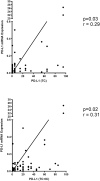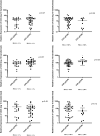Profiling non-small cell lung cancer reveals that PD-L1 is associated with wild type EGFR and vascular invasion, and immunohistochemistry quantification of PD-L1 correlates weakly with RT-qPCR
- PMID: 33956842
- PMCID: PMC8101740
- DOI: 10.1371/journal.pone.0251080
Profiling non-small cell lung cancer reveals that PD-L1 is associated with wild type EGFR and vascular invasion, and immunohistochemistry quantification of PD-L1 correlates weakly with RT-qPCR
Abstract
Most lung cancer patients are diagnosed at an advanced stage, limiting their treatment options with very low response rate. Lung cancer is the most common cause of cancer death worldwide. Therapies that target driver gene mutations (e.g. EGFR, ALK, ROS1) and checkpoint inhibitors such anti-PD-1 and PD-L1 immunotherapies are being used to treat lung cancer patients. Identification of correlations between driver mutations and PD-L1 expression will allow for the best management of patient treatment. 851 cases of non-small cell lung cancer cases were profiled for the presence of biomarkers EGFR, KRAS, BRAF, and PIK3CA mutations by SNaPshot/sizing genotyping. Immunohistochemistry was used to identify the protein expression of ALK and PD-L1. Total PD-L1 mRNA expression (from unsorted tumor samples) was quantified by RT-qPCR in a sub-group of the cohort to assess its correlation with PD-L1 protein level in tumor cells. Statistical analysis revealed correlations between the presence of the mutations, PD-L1 expression, and the pathological data. Specifically, increased PD-L1 expression was associated with wildtype EGFR and vascular invasion, and total PD-L1 mRNA levels correlated weakly with protein expression on tumor cells. These data provide insights into driver gene mutations and immune checkpoint status in relation to lung cancer subtypes and suggest that RT-qPCR is useful for assessing PD-L1 levels.
Conflict of interest statement
The study was partially supported by Roche Canada, Pfizer Canada and Boehringer Ingelheim Canada. The funders had no role in study design, data collection and analysis, decision to publish, or preparation of the manuscript. The funding provided by the pharmaceutical companies were helping us for validation of the tests and not related to employment, consultancy, patents, products in development, marketed products, and any commercial purposes. This does not alter our adherence to PLOS ONE policies on sharing data and materials.
Figures



References
-
- Canadian Cancer Statistics: Canadian Cancer Society. undefined, cancer.ca/Canadian-Cancer-Statistics-2019-EN. (2019).
Publication types
MeSH terms
Substances
Grants and funding
LinkOut - more resources
Full Text Sources
Other Literature Sources
Medical
Research Materials
Miscellaneous

